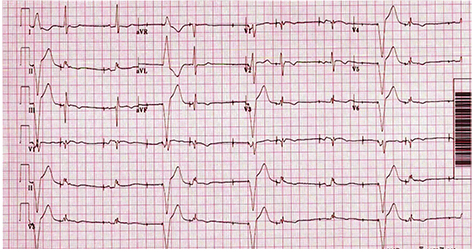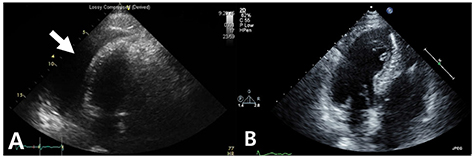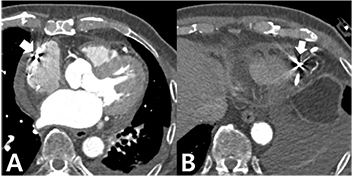Transl Clin Pharmacol.
2017 Sep;25(3):138-140. 10.12793/tcp.2017.25.3.138.
Hemorrhagic pericarditis associated with rivaroxaban in an atrial fibrillation patient with pacemaker
- Affiliations
-
- 1HappyView Hospital, Dongku, Gwangju 61453, Korea.
- 2Assistant Professor of Division of Cardiology of Chosun University Hospital, Dongku, Gwangju 61453, Korea. kholywater@gmail.com
- KMID: 2390933
- DOI: http://doi.org/10.12793/tcp.2017.25.3.138
Abstract
- Rivaroxaban is a new oral anticoagulant used for the prevention of stroke in patients with atrial fibrillation. Hemorrhagic pericarditis is known to occur with rivaroxaban; however, only a few case reports in the literature describe such events. Recently, we experienced hemorrhagic pericarditis that treated with rivaroxaban for anticoagulation of newly diagnosed, non valvular AF patients with pacemaker. An 83 year old male with permanent pacemaker receiving rivaroxaban 20 mg daily once for 3 months presented at our emergency department complaining of exertional dyspnea. ECG showed intermittent atrial pacing failure and echocardiography showed large amount of pericardial effusion. After urgent pericardiocentesis, which resulted in removal of 500cc bloody fluid, there was an immediate and dramatic improvement in the patient's clinical state. He was discharged without anticoagulation therapy due to concern for further bleeding. This case highlight the potential for bleeding complications associated with novel anticoagulants. Rivaroxaban is being used with increasing frequently in outpatient care. However, no available laboratory test specifically measures the anticoagulant effect of rivaroxaban. Also, in the events of serious bleeding, no specific antidotes, reversal agents were available. Clinicians should be aware of the possibility of hemopericardium in patients treated with anticoagulants, including rivaroxaban who presented with cardiomegaly.
MeSH Terms
Figure
Reference
-
1. Fox KA, Piccini JP, Wojdyla D, Becker RC, Halperin JL, Nessel CC, et al. Prevention of stroke and systemic embolism with rivaroxaban compared with warfarin in patients with non-valvular atrial fibrillation and moderate renal impairment. Eur Heart J. 2011; 32:2387–2394. DOI: 10.1093/eurheartj/ehr342.
Article2. Piccini JP, Garg J, Patel MR, Lokhnygina Y, Goodman SG, Becker RC, et al. Management of major bleeding events in patients treated with rivaroxaban vs. warfarin: results from the ROCKET AF trial. Eur Heart J. 2014; 35:1873–1880. DOI: 10.1093/eurheartj/ehu083.
Article3. Shivamurthy P, Brar N, Therrien ML. Isolated hemopericardium associated with rivaroxaban: first case report. Pharmacotherapy. 2014; 34:e169–e172. DOI: 10.1002/phar.1474.
Article4. Boone S. Cardiac tamponade associated with rivaroxaban. Del Med J. 2015; 87:206–207.5. Xu B, MacIsaac A. Life-threatening haemorrhagic pericarditis associated with rivaroxaban. Int J Cardiol. 2014; 174:e75–e76. DOI: 10.1016/j.ijcard.2014.04.151.
Article6. Halperin JL, Hankey GJ, Wojdyla DM, Piccini JP, Lokhnygina Y, Patel MR, et al. Efficacy and safety of rivaroxaban compared with warfarin among elderly patients with nonvalvular atrial fibrillation in the Rivaroxaban Once Daily, Oral, Direct Factor Xa Inhibition Compared with Vitamin K Antagonism for Prevention of Stroke and Embolism Trial in Atrial Fibrillation (ROCKET AF). Circulation. 2014; 130:138–146. DOI: 10.1161/CIRCULATIONAHA.113.005008.
Article7. Kirchhof P, Benussi S, Kotecha D, Ahlsson A, Atar D, Casadei B, et al. 2016 ESC Guidelines for the management of atrial fibrillation developed in collaboration with EACTS. Eur Heart J. 2016; 37:2893–2962.
Article
- Full Text Links
- Actions
-
Cited
- CITED
-
- Close
- Share
- Similar articles
-
- Application of New Oral Anticoagulants: Prevention of Stroke in Patients with Nonvalvular Atrial Fibrillation
- Incidence of Atrial Fibrillation and Cerebral Stroke in Patients Treated with Ventricular Pacing and Dual-Chamber Pacing
- One Case of Clinically Suspected Hemorrhagic Fever Accompanied by Acute Pericarditis with Pericardial Effusion
- New oral anticoagulants
- Delayed bleeding after implant surgery in patients taking novel oral anticoagulants: a case report





